Military Health System beneficiaries are a diverse and heterogeneous population: Individuals who are eligible for care through the MHS include active component service members, activated National Guard and Reserve service members, family members of active component members, retirees, and family members of retirees. Each of these beneficiary categories has different demographics, enrollment, and utilization patterns.
An important distinction of beneficiary care is the transition from TRICARE to Medicare. Once an individual reaches age 65, TRICARE eligibility ends, as beneficiaries become eligible for Medicare. If they enroll in Medicare, those individuals receive a Medicare gap insurance, known as TRICARE for Life. TFL is funded through mechanisms outside of the Defense Health Program. While TFL patients are eligible for Click to closeDirect CareDirect care refers to military hospitals and clinics, also known as “military treatment facilities” and “MTFs.”direct care at military hospitals and clinics, most care is provided at civilian institutions, paid through the Medicare benefit. While Medicare-eligible individuals remain eligible for direct care at a military medical facilities, such care is on a space-available basis.
Beneficiaries enrolled in TRICARE Prime and TRICARE Select, which includes many family members of active duty service members and a portion of non-Medicare eligible retirees and their family members (primarily those aged 64 and younger), may receive care at fixed military hospitals and clinics or from civilian health care resources (Click to closePurchased CareThe TRICARE Health Program is often referred to as purchased care. It is the services we “purchase” through the managed care support contracts.purchased care) that supplement direct military medical care.1 In 2022, approximately 6.66 million non-service member beneficiaries utilized health care services through the MHS.1
This report provides an updated summary of care provided to non-service members in the MHS during calendar year 2022. Health care burden estimates are stratified for 4 age groups of health care recipients. Medicare-eligible beneficiaries (over age 65) are considered separately, as most of their care is provided and paid for by non-MHS resources.
What are the new findings?
In 2022, mental health disorders accounted for the largest proportions of the morbidity and health care burdens that affected the pediatric and younger adult beneficiary age groups. Among adults aged 45-64 and those aged 65 or older, musculoskeletal diseases accounted for the most morbidity and health care burdens. Nearly all care for Medicare-eligible beneficiaries (those over age 65 along with select other groups) was at non-military medical facilities, which resulted in over 90% of total non-service member beneficiaries encounters (Medicare-eligible and TRICARE-eligible) at non-military medical facilities.
What is the impact on readiness and force health protection?
Service member focus and morale are improved by the assurance of medical care to family members, especially during deployment or other periods of separation. The promise of lifetime medical benefits upon retirement for a service member and immediate family has been a powerful recruiting and retention tool over the past several decades. Non-member beneficiaries provide important opportunities for active duty health care providers to maintain medical skills, knowledge, and abilities, improving the readiness of the medical force. Trends in utilization and diagnostic patterns can help senior leaders allocate health care resources within the Military Health System to maximize efficiency, medical readiness, and the readiness of the medical force.
Methods
The surveillance population included all non-service member beneficiaries of the MHS who had at least one hospitalization or outpatient medical encounter from January 1 through December 31, 2022, either through a military medical facility or provider or a civilian facility or provider (if reimbursed through TRICARE or through Medicare with a copay by TFL). For this analysis, all inpatient and outpatient medical encounters were summarized according to the primary (first-listed) International Classification of Diseases, 10th Revision (ICD-10) codes that indicate the natures of illnesses or injuries (i.e., ICD-10 codes A00–T88). Nearly all records of encounters with first-listed diagnoses that were Z-codes (care other than for a current illness or injury—e.g., general medical examinations, after care, vaccinations) or V/W/X/Y-codes (indicators of the external causes but not the natures of injuries)—were excluded from the analysis; encounters with a code of Z37 (“outcome of delivery, single liveborn”) in the primary position were retained.
For summary purposes, all illness- and injury-specific diagnoses (as defined by the ICD-10) were grouped into 153 burden of disease-related conditions and 25 major morbidity categories based on a modified version of the classification system developed for the Global Burden of Disease Study.2 The methodology for summarizing absolute and relative morbidity has been used annually since 2014 and described elsewhere.3 Results were stratified by source of health care (direct care [military treatment facilities] vs. non-direct care [non-military medical facilities]) and by age group (0-17 years, 18-44 years, 45-64 years, and 65 years old or older). For analysis of morbidity burdens within the youngest age group, developmental disorders were included in the general category of mental health disorders.
Results
In 2022, the population of non-service member MHS care recipients included more female beneficiaries (56.8%) than male beneficiaries (43.2%). Adults aged 65 years and older accounted for the highest number of individuals receiving health care (n=2.07 million; 31.6%), followed by adults 18-44 years old (n=1.58 million; 24.1%), pediatric beneficiaries under 17 years of age (n=1.47 million; 22.5%), and older adults 45-64 years of age (n=1.43 million; 21.8%) (Table 1).
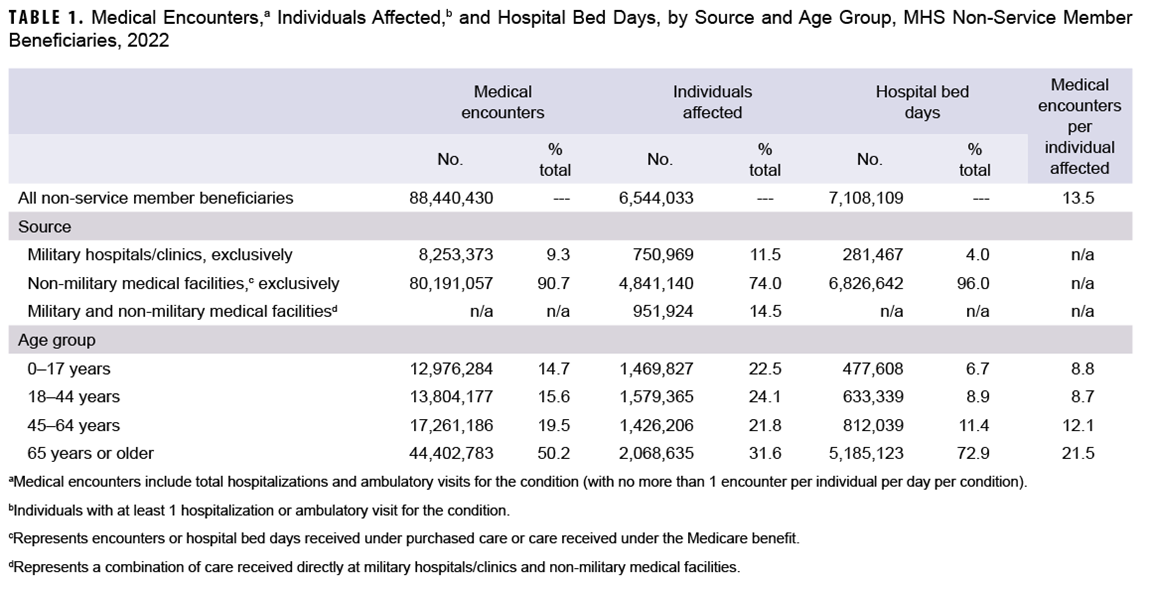
In 2022, a total of 6,544,033 non-service member beneficiaries of the MHS experienced 88,440,430 medical encounters. The 2,068,635 beneficiaries over age 65 accounted for over half (50.2%) of these encounters (Table 1). Among TRICARE-eligible beneficiaries (under age 65), the three most frequent morbidity-related categories accounting for the most medical encounters were mental health disorders, signs/symptoms and ill-defined conditions, and injury/poisoning. While mental health disorders and injury also accounted for 1 of the 3 highest morbidity-related groupings for hospital bed days, maternal conditions accounted for the second-most bed days among beneficiaries under 65 years of age (Figures 1a, 1b).
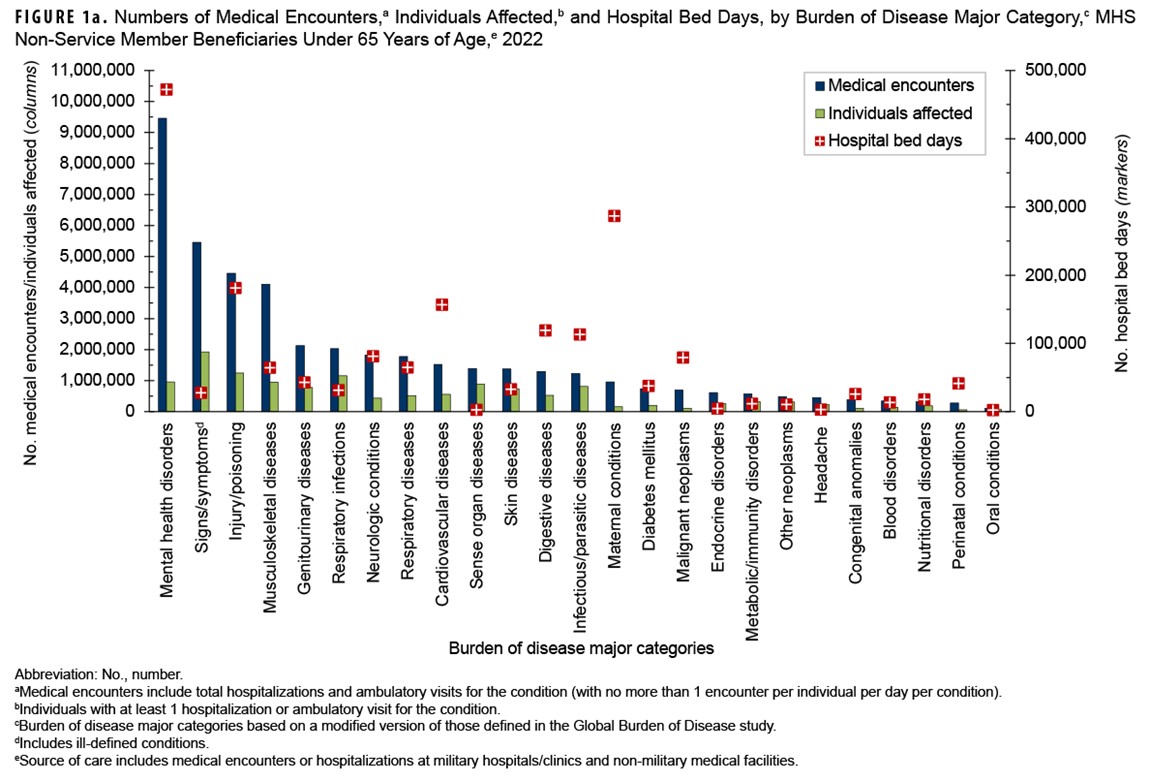
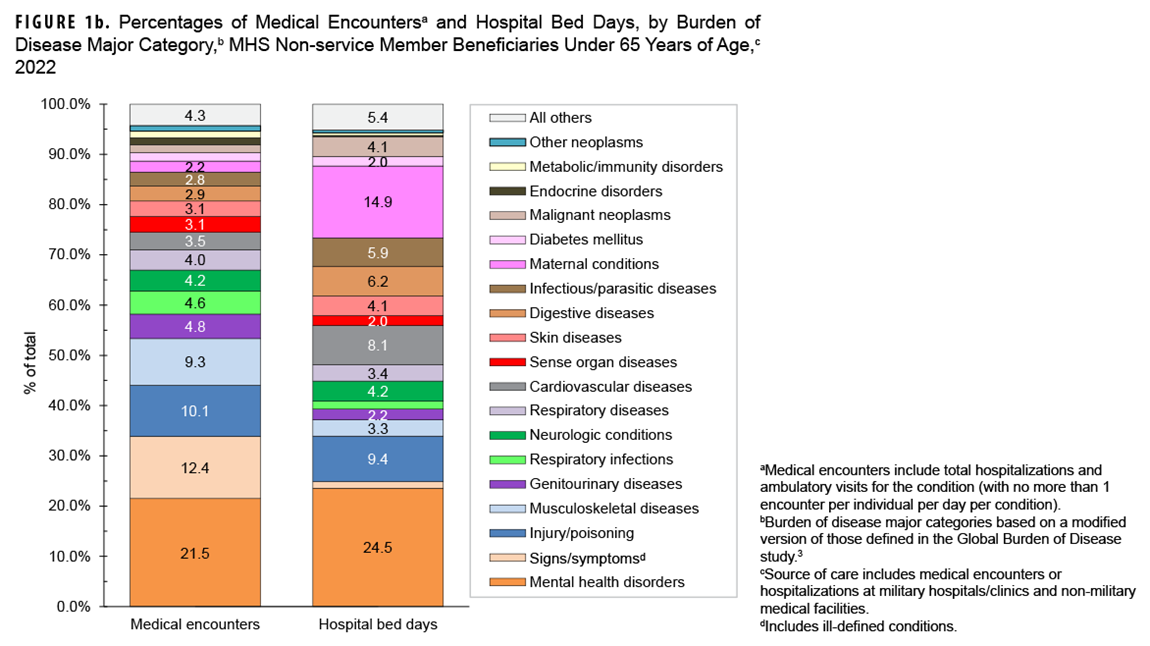
Direct care versus care at non-military medical facilities
Most medical encounters (90.7%) among non-service member beneficiaries in 2022 were at non-military medical facilities (purchased care or care received under the Medicare benefit) (Table 1). Of all non-service member beneficiaries (individuals affected) with any illness or injury-related encounters during the year, many more exclusively received their care in non-military medical facilities (n=4,841,140; 74.0%) than either exclusively by military medical (direct) care (n=750,969; 11.5%) or a combination of both (n=951,924; 14.5%).
The highest proportion of care among beneficiaries of all age groups was exclusively from non-military hospitals or clinics. While individuals under 64 years of age utilized both direct and non-direct care within a range of 16.7% to 19.6%, combined care among beneficiaries ages 65 and older was lower (6.6%). Medicare-eligible beneficiaries (over age 65) accounted for the largest age-specific proportion of care exclusively outside military hospitals and clinics (91.0%); accordingly, just 2.5% received care exclusively in military hospitals or clinics (Table 2).

Pediatric beneficiaries (aged 0 to 17)
In 2022, pediatric beneficiaries accounted for 14.7% of all medical encounters, 22.5% of all individuals affected, and 6.7% of all hospital bed days (Table 1). On average, each pediatric beneficiary experienced 9 medical encounters during the year. Among TRICARE-eligible beneficiaries (excluding Medicare-eligible beneficiaries 65 and older), this group accounted for 29.5% of medical encounters, 32.8% of individuals affected, and 24.8% of all bed days.
Mental health disorders represented the largest burden of disease among pediatric beneficiaries when examining all medical encounters (37.1%; n=4,811,215) and hospital bed stays (59.2%; n=282,905) (Figures 2a, 2b).
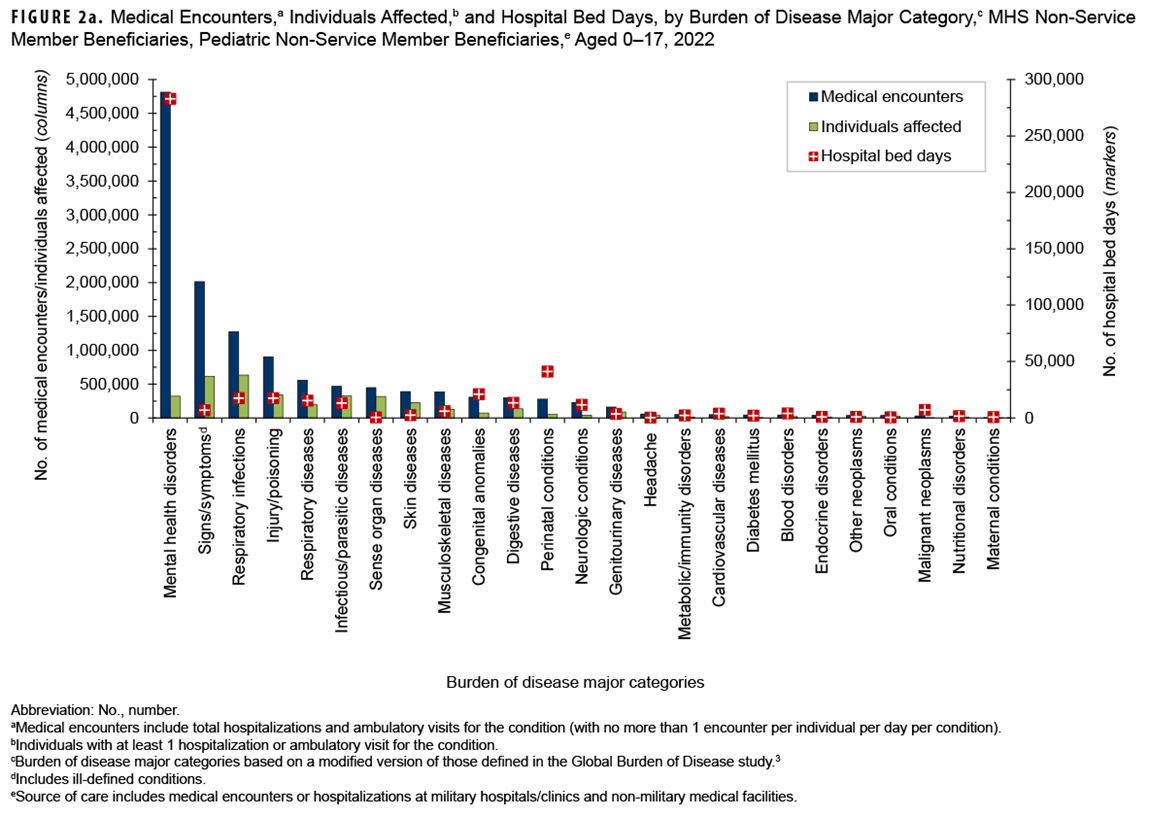
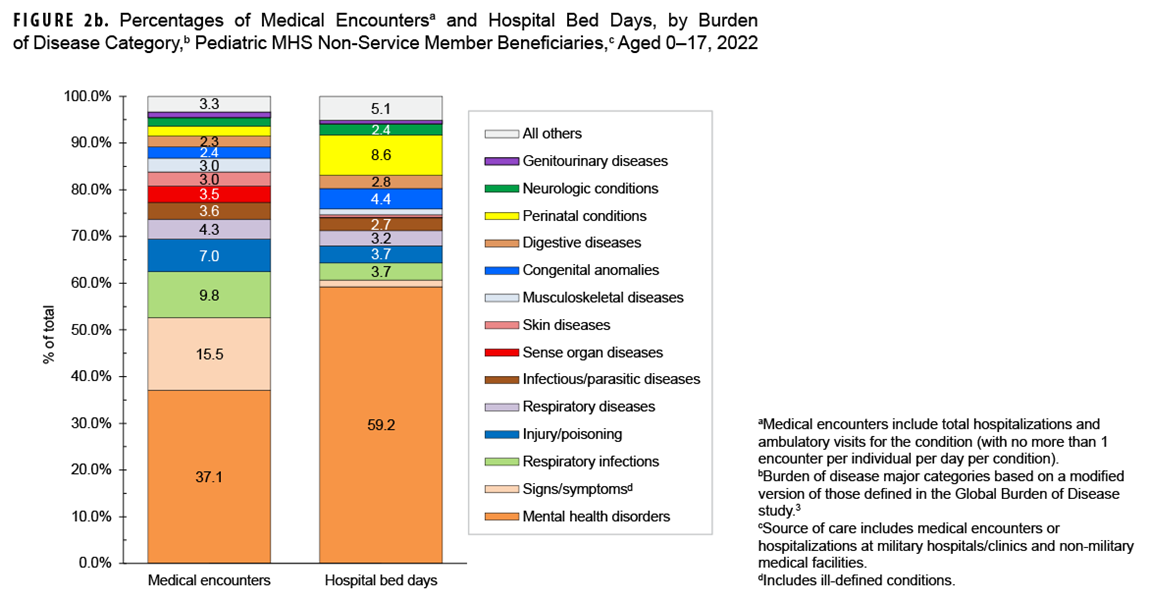
On average, pediatric beneficiaries affected by a mental health disorder had 15 medical encounters related to this morbidity category during the year (data not shown). More than two-thirds (67.0%) of all medical encounters for mental health disorders among pediatric beneficiaries were attributed to three groups of disorders: autism-related disorders (31.1%), followed by developmental disorders of speech and language (25.7%), and attention-deficit hyperactivity disorders (10.2%) (Figure 2c).
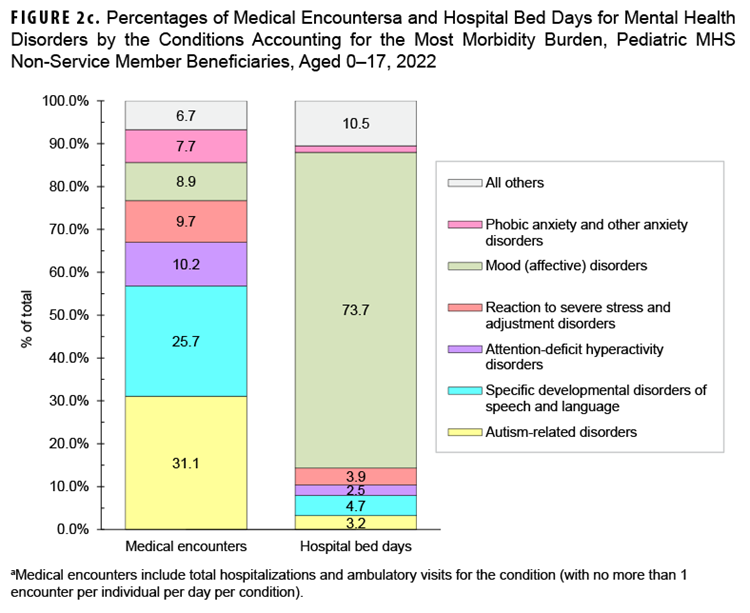
On average, there were 41 autism-related encounters per individual affected by an autistic disorder (data not shown). Despite the high numbers of encounters associated with these three categories of mental health disorders, approximately three-quarters (73.7%) of mental health disorder-related hospital bed days were attributable to mood disorders, and 29.8% of mood disorder-related bed days were attributable to “major depressive disorder, recurrent, severe without psychotic features (ICD10: F332)” (data not shown).
Among pediatric beneficiaries overall, perinatal conditions (i.e., medical issues occurring within 1 year of birth) accounted for the second highest number of hospital bed days (n=41,114; 8.6%) after mental health disorders (Figures 2a, 2b). Among pediatric beneficiaries with at least 1 illness or injury-related diagnosis, those with malignant neoplasms had the second-highest number (14) of related encounters per affected individual. The highest numbers of malignant neoplasm-related encounters and hospital bed days were attributable to leukemias (data not shown).
Respiratory infections (including upper and lower respiratory infections and otitis media) accounted for relatively more medical encounters among pediatric beneficiaries (9.8%) when compared to any older age group of beneficiaries (Figures 2b, 3b, 4b, and 5b). Respiratory infections were attributed to a larger proportion of hospital bed days for adults 65 and older (6.5%) than pediatric beneficiaries (3.2%).
Beneficiaries aged 18 to 44
In 2022, non-service member beneficiaries aged 18-44 accounted for 15.6% of all medical encounters, 24.1% of all individuals affected, and 8.9% of hospital bed days (Table 1). On average, each individual affected with an illness or injury (any cause) had 9 medical encounters during the year. Excluding those eligible for Medicare according to age, non-service member beneficiaries aged 18-44 accounted for 31.3% of all medical encounters, 35.3% of individuals affected, and 32.9% of all bed days in 2022.The morbidity-related category that accounted for the most medical encounters among beneficiaries aged 18-44 was mental health disorders (n=3,309,402; 24.0% of all encounters) (Figures 3a, 3b). Among these adult beneficiaries, mental health disorders accounted for over one-fifth (21.3%) of all bed days, and on average, each adult affected by a mental health disorder had 8 mental health disorder-related encounters during the year. Anxiety disorders (33.9%), mood disorders (29.9%), and adjustment disorders (16.5%) accounted for approximately four-fifths (80.3%) of all mental health disorder-related medical encounters among beneficiaries aged 18-44 (data not shown). Among adult beneficiaries in this age group, mood and substance abuse disorders accounted for over three-quarters (50.3% and 24.1%, respectively) of total mental health disorder-related hospital bed days.
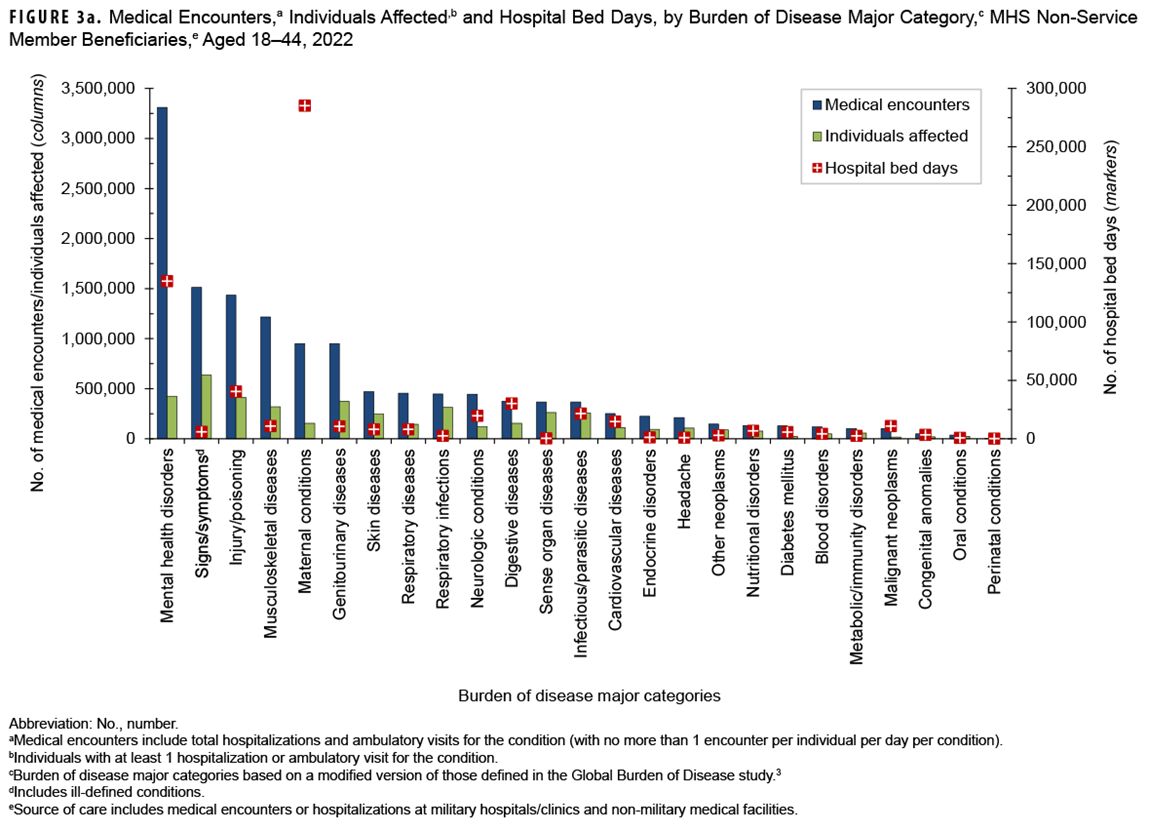
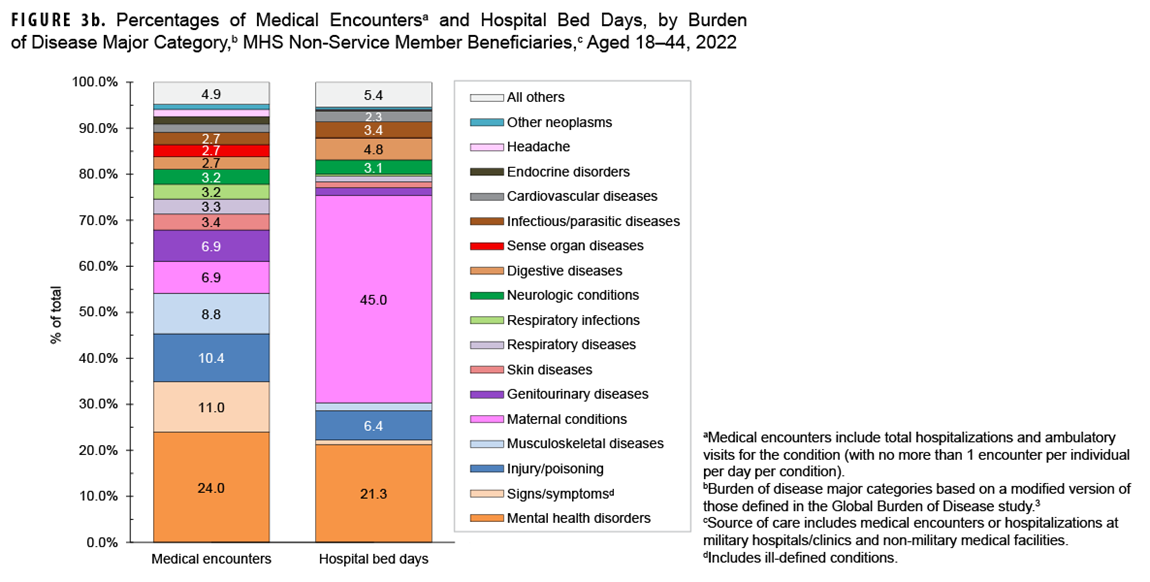
Maternal conditions accounted for more than two-fifths (45.0%) of all bed days among adults aged 18-44, and on average, 6 medical encounters per affected individual (Figures 3a, 3b). Deliveries accounted for 9.8% of maternal condition-related medical encounters (data not shown).
Examination of an average number of medical encounters per person within a respective morbidity category identified malignant neoplasms as a diagnostic group accounting for individual health care use (6.4 encounters per individual) relatively comparable to mental health disorders (7.8 encounters per individual) and maternal conditions (6.1 encounters per individual). Of the 101,006 medical encounters for malignant neoplasms among adults aged 18-44, 29.5% were attributed to malignant neoplasm of the breast (data not shown).
Beneficiaries aged 45 to 64
In 2022, non-service member beneficiaries aged 45-64 accounted for approximately one-fifth (19.5%) of all medical encounters, 21.8% of all individuals affected, and 11.4% of hospital bed days (Table 1). On average, each affected individual had 12 medical encounters during the year. Excluding Medicare-eligible beneficiaries, this group accounted for 39.2% of medical encounters, 31.9% of individuals affected, and 42.2% of all bed days.
Of all morbidity-related categories, musculoskeletal diseases accounted for the most medical encounters (n=2,509,110; 14.5%) among older adult beneficiaries aged 45-64 (Figures 4a, 4b); back problems accounted for 42.5% of these musculoskeletal disease-related encounters (data not shown). Cardiovascular diseases represented the highest proportion of hospital bed days (17.0%), second to injury/poisoning (15.1%) (data not shown). Digestive diseases (9.3%) and malignant neoplasms (7.6%) accounted for a larger percentage of total hospital bed days among beneficiaries compared to other age groups. Malignant neoplasm of the breast represented the leading cause of neoplasm-related encounters (25.7%) in adult beneficiaries ages 45-64 (data not shown).
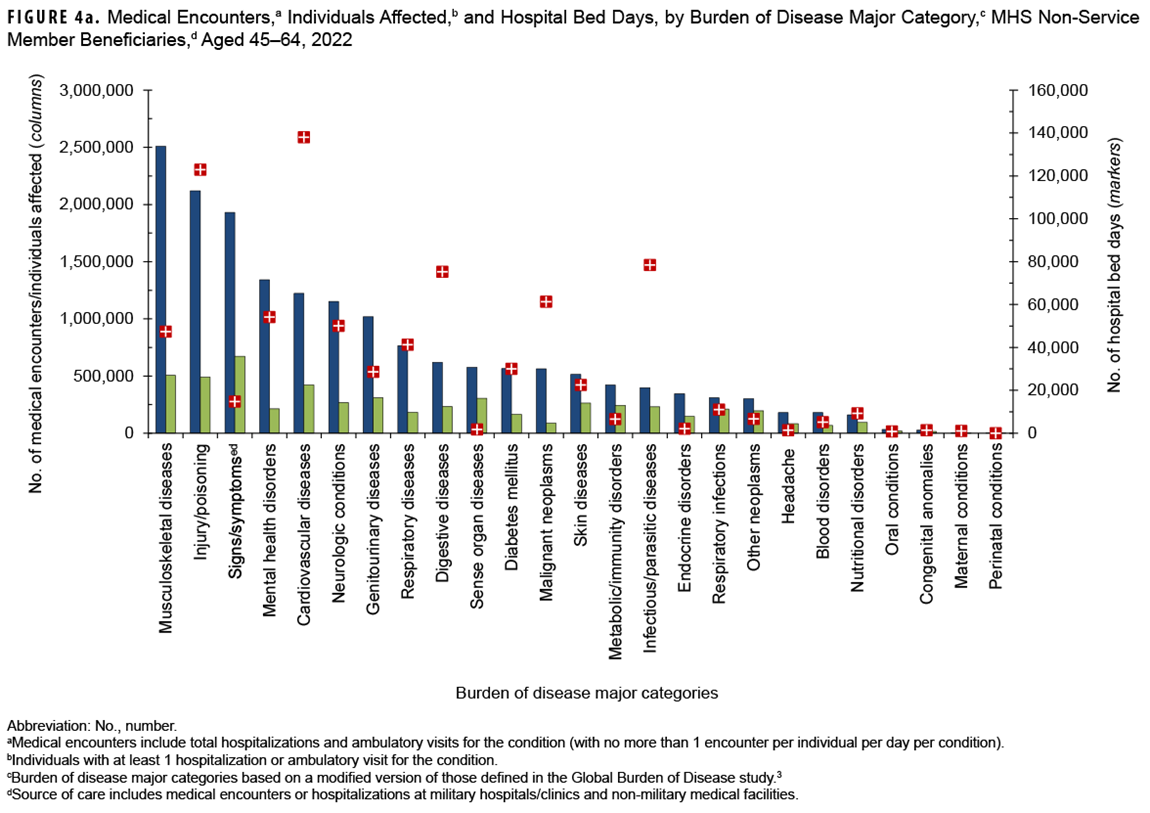
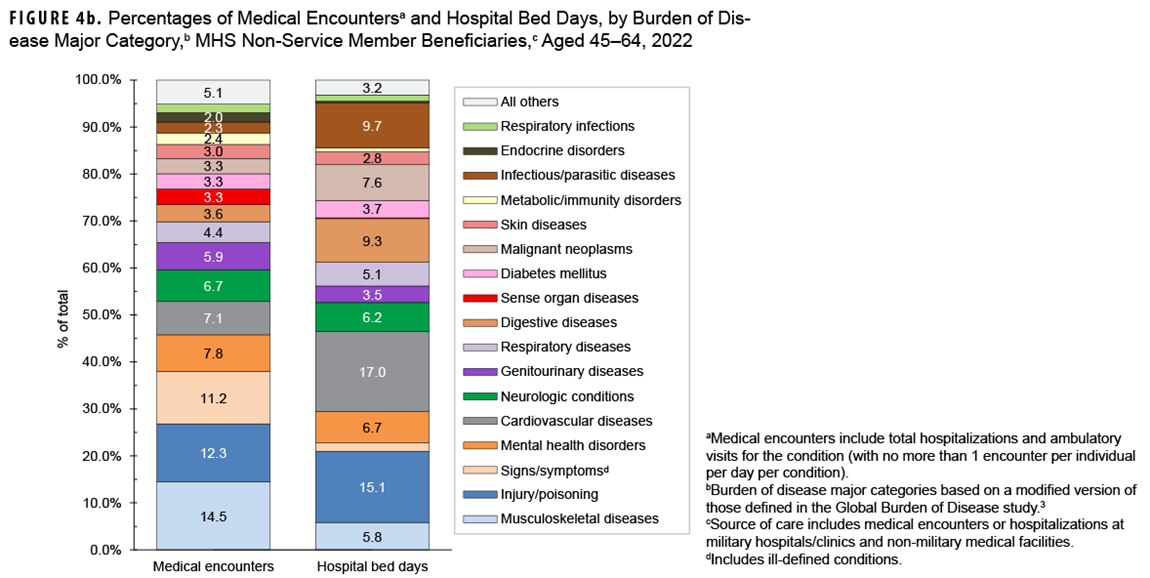
Beneficiaries aged 65 or older (Medicare-eligible or TFL)
In 2022, non-service member beneficiaries aged 65 or older accounted for more medical encounters and more than 2.5 times the number of hospital bed days than all other age groups combined. On average, each affected individual had 21 medical encounters during the year. In addition, the number of individuals affected was greater than any other age group (Table 1).
Musculoskeletal diseases (n=6, 443,154; 14.5%) and cardiovascular diseases (n=6,082,418; 13.7%) together represented the leading causes for medical encounters among beneficiaries aged 65 or older, while cardiovascular diseases as a discrete cause accounted for the most bed days (1,201,613 days; 23.2%) (Figures 5a, 5b). Back problems accounted for a little more than one-third (35.8%) of all musculoskeletal disease-related medical encounters (data not shown).
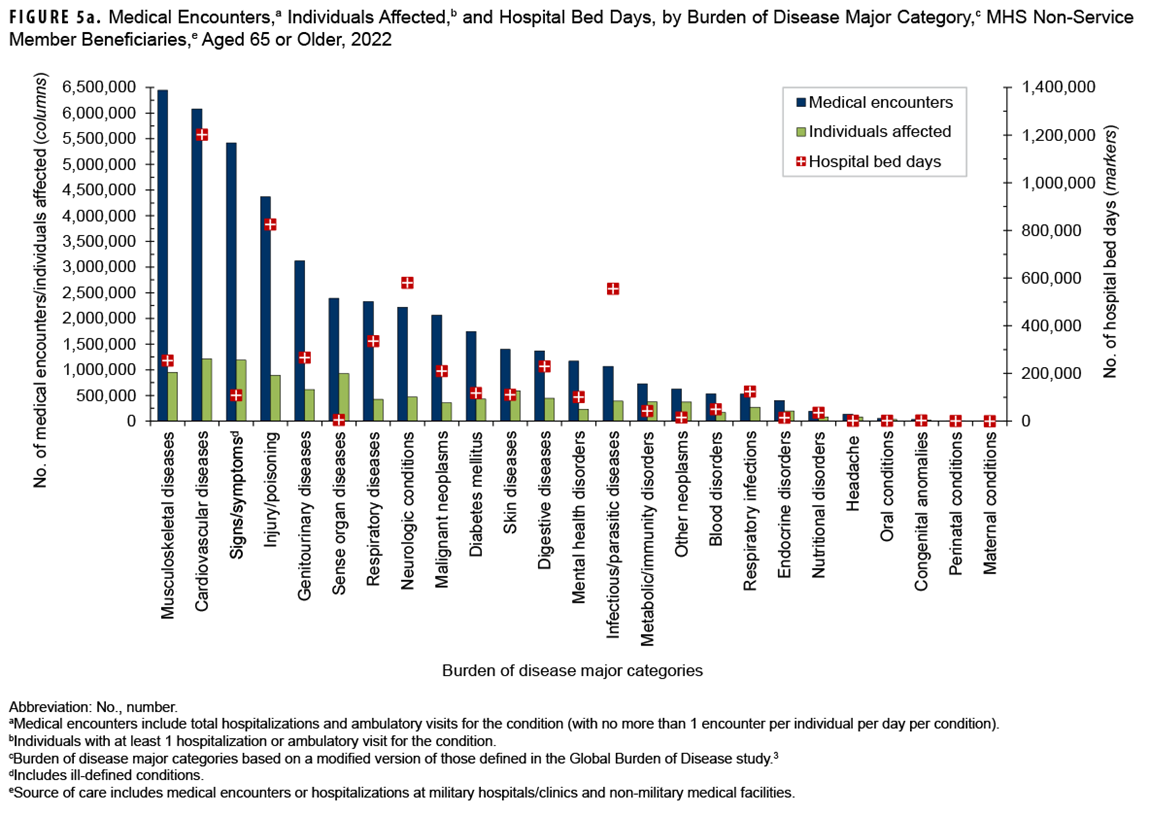
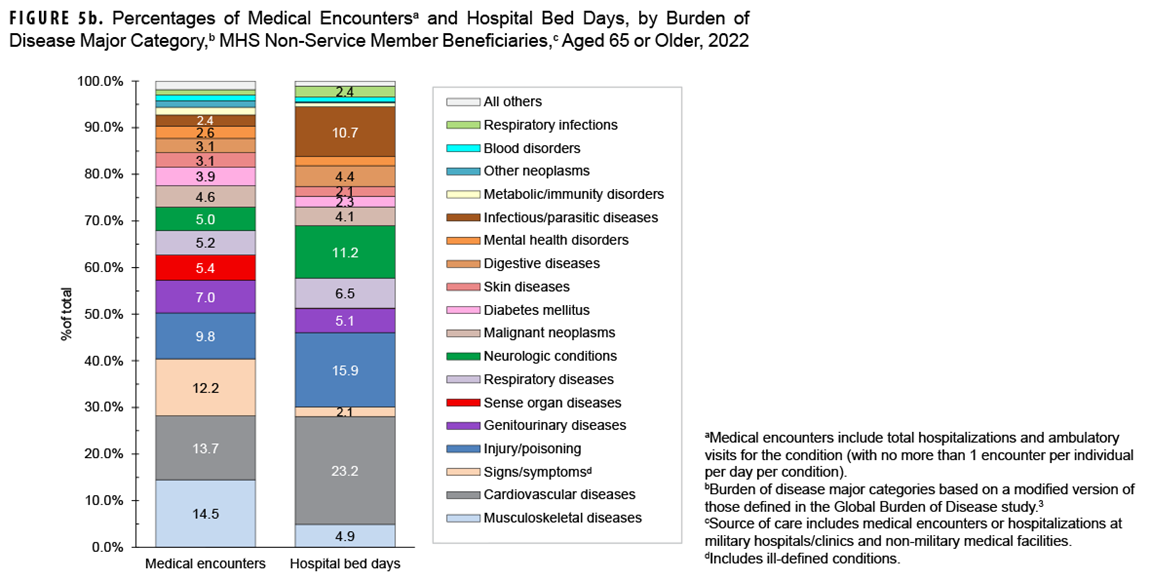
Discussion
This report documents health care among non-service member beneficiaries through direct care at military hospitals and clinics, non-military medical facility purchased care reimbursements, and Medicare services external to the MHS. A substantial majority of individuals received care exclusively from non-military medical clinics and hospitals, reflecting the fact that just under 10% of all ambulatory encounters documented in DMSS were provided from a direct care military medical facility in 2022. This low figure is somewhat misleading, however, as most encounters and bed days among non-service member beneficiaries are attributable to Medicare-eligible (65 or older) beneficiaries who are often distant from military hospitals and clinics and can generally only receive direct care if space is available.
The National Ambulatory Medical Care Survey of 2019 documents a substantially lower rate of ambulatory visits (3.2 visits per p-yr) among the general U.S. population than among non-service member MHS beneficiaries (13.5 visits per p-yr) reported here.4 This increased rate of ambulatory visits among non-service member beneficiaries compared to national civilian data was observed for all age groups. Future analyses comparing the major diagnostic category rates to civilian counterparts, by age and sex, may be useful to identify longitudinal morbidity outcomes unique to military service. Since the National Ambulatory Medical Care survey includes uninsured individuals, the financial barrier to care may explain a portion of the lower overall utilization rate.
Pronounced differences between beneficiary age groups are evident for types of morbidity-related diagnoses and disease-specific conditions. Individuals aged 65 or older—31.6% of all non-service member beneficiaries receiving an illness- or injury-specific diagnosis in 2022—accounted for approximately half (50.2%) of all medical encounters and nearly two-thirds (72.9%) of all hospital bed days among all beneficiaries. As those individuals receive care primarily through a Medicare benefit at non-MHS facilities, the impact on the MHS is minimal.
While ambulatory encounters among non-service member beneficiaries in 2022 remained relatively stable (2.1% increase) compared to the previous year, the crude annual difference in hospital bed days increased by over 20%. This trend was influenced by hospital bed days for beneficiaries ages 65 and older, among whom hospital bed days for cardiovascular disease increased from 787,739 bed days in 2021 to 1,201,613 bed days in 2022. The number of individuals 65 years and older affected by cardiovascular disease remained stable (from 1,211,692 individuals in 2021 to 1,213,404 individuals in 2022). Since this report does not include person-time nor approximate rates, annual comparisons are not proportionate to changes in the number of beneficiaries utilizing care. Further investigation of this finding may be of interest to MHS researchers.
In 2022, as in previous years, mental health disorders were the leading cause for medical encounters among pediatric (aged 0-17) and young adult (aged 18-44) beneficiary age groups, although the proportion of medical encounters attributed to mental health disorders was markedly lower among young adult (24.0%) than pediatric (37.1%) beneficiaries. Developmental disorders were a significant factor for pediatric beneficiary health care, with 67% of medical encounters for mental health disorders attributable to autism-related disorders, specific developmental disorders of speech and language, or attention-deficit hyperactivity disorders. Children affected by autistic disorder had an average of 41 autism-related encounters in 2022. Among young adult beneficiaries, the mental health disorders accounting for the largest health care burdens included anxiety, mood, and adjustment disorders.
As the MHS completes its transition to the new MHS GENESIS electronic health record, AFHSD is also in the process of completely transferring or mapping EHR data to the Defense Medical Surveillance System. During the transition to the new MHS Information Platform, the number of records transmitted from MHS GENESIS and the Tricare Encounter Detail to DMSS are being continually reviewed for completeness of data capture. The annual burden summary for active component service members indicated a substantial drop in the number of ambulatory encounters as well as incomplete data elements.5 This limitation was not seen among non-service member beneficiaries, however, as the number of ambulatory encounters remained relatively stable and hospital bed days increased substantially. This limitation appears to be primarily related to administrative (“Z”) codes, which were excluded from this analysis.
While this report aims to describe morbidity-related diagnoses for all MHS beneficiaries, the data are limited to beneficiaries who received care at military hospitals and clinics or at a non-military medical facilities that was reimbursed through TRICARE (as primary or secondary insurance) or through Medicare, if TFL was also billed. Certain care, e.g., paid with other health insurance and not billed to TRICARE, or paid directly by the patient (or family member), is not captured in this report.
References
- Department of Defense. Evaluation of the TRICARE Program: Fiscal Year 2022 Report to Congress: Access, Cost, and Quality Data Through Fiscal Year 2022. Accessed 18 May 2023. https://www.health.mil/Reference-Center/Reports/2022/10/07/Evaluation-of-the-TRICARE-Program-FY-2022-Report-to-Congress
- Armed Forces Health Surveillance Center. Absolute and relative morbidity burdens attributable to various illnesses and injuries, non-service member beneficiaries of the Military Health System, 2013. MSMR. 2014;21(4):23-30.
- Murray CJ and Lopez AD, eds. In: Global Burden of Disease: A Comprehensive Assessment of Mortality and Disability from Diseases, Injuries, and Risk Factors in 1990 and Projected to 2020. Cambridge, MA: Harvard University Press; 1996:120-122.
- National Ambulatory Health Care Survey: 2019 National Summary. Accessed July 19, 2023. National Ambulatory Medical Care Survey: 2019 National Summary (cdc.gov).
- Armed Forces Health Surveillance Center. Ambulatory visits among active component members, U.S. Armed Forces, 2022. MSMR. 2023;30(6): 19-25.